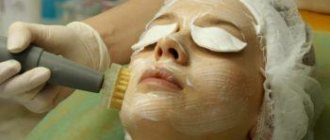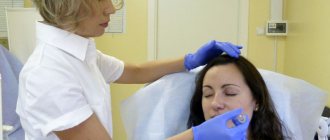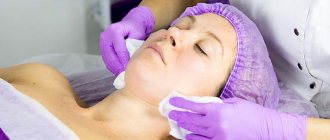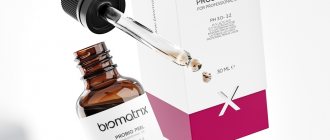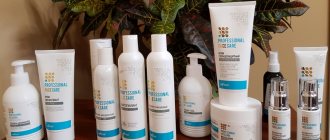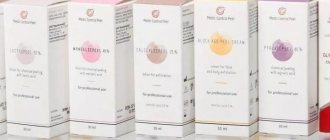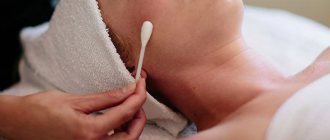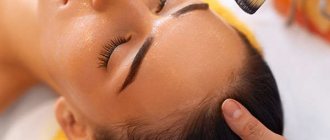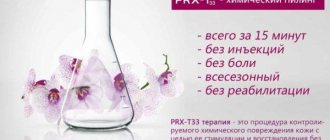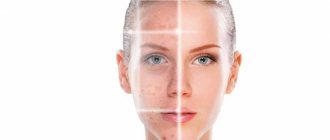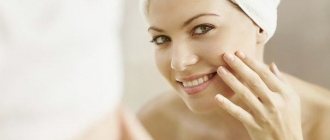What is the difference: home peeling and peeling at a cosmetologist
Peels that can be used at home do not penetrate deeply into the skin and give an unnoticeable result, but they certainly help maintain an even tone and healthy skin. Chemical peels performed by estheticians have a lower pH level than at-home peels, so they can penetrate much deeper into the skin and target skin problems such as hyperpigmentation and acne. Chemical peels can cause redness of the skin; a recovery period will last for several days, during which the “old” skin will gradually peel off and renewed skin will appear.
Chemical peeling performed by cosmetologists will be much more effective for your skin than peeling at home.
Mechanism of chemical peeling
Essentially, a chemical peel is a controlled burn of a specific area of the skin. Such an effect is necessary to restore the protective properties of the skin, forcing cells to renew and produce active substances. As a rule, the procedure is performed on the face (chemical peeling of the face), but it is also possible to treat other parts of the body - neck, hands, décolleté.
The degree of burn depends on the concentration of acid in the composition. After exfoliation (removal of the upper layers of the dermis), the cells begin to actively renew themselves and produce growth factors. The skin actively produces hyaluronic acid, and new elastin and collagen molecules are produced. This helps to moisturize and tighten the skin, increasing its elasticity.
Along with the improvement of skin tone, its texture is evened out and small surface wrinkles are smoothed out. The procedure also helps to get rid of other skin defects (hyperpigmentation, post-acne, scars).
Summarizing the above, we can say that chemical peeling helps:
- refresh and rejuvenate the face;
- remove age spots;
- cause activation of skin cells (due to anti-inflammatory effect);
- stimulate the active production of hyaluronic acid (i.e. achieve skin hydration);
- achieve restoration of density and elasticity of the epidermis;
- achieve rejuvenation of the structure of the dermis;
- restore the protective properties of the skin (restoration of the skin barrier).
1 Facial cleansing before peeling
2 Superficial chemical peeling procedure
3 Superficial chemical peeling procedure
Contraindications:
- The procedure is not recommended for pregnant and lactating women;
- When taking medications based on isotretinoin;
- For herpes and skin diseases;
- When taking antibiotics;
- For oncological diseases;
- For open wounds.
After a chemical peel, the skin is more sensitive to sunlight, so after the procedure it is necessary to use sunscreens and products.
Before the procedure, the cosmetologist must take into account many factors and ask all the necessary questions so that the procedure is as comfortable as possible for the client and gives the best result with the fewest possible side effects.
Preparation for the session and rehabilitation period
Regardless of the method of exposure, the procedure requires preliminary preparation and subsequent rehabilitation, which includes a number of restrictions:
- Avoid exposure to ultraviolet radiation, visiting a sauna or steam bath for a month before medium and deep peeling;
- Avoid any cosmetic procedures for a week;
- Do not use cosmetics for at least two days before the session;
- After the session, use only products prescribed by your doctor.
- You can wash your face with superficial peeling one day after the procedure, with medium peeling - after two days.
How is peeling performed and what should you pay attention to after the procedure?
Before the procedure, the skin is cleansed and “degreased”. During the procedure, you will feel warmth and burning on the treated skin surface. To reduce discomfort, you can use a fan or local anesthetic. After peeling, first of all, take care of protecting your skin from the sun, so it is not recommended to carry out the procedure at the height of summer or before leaving for warm countries.
After peeling, you will feel tightness and slight dryness of the skin. The skin may remain red for an hour after the procedure. The condition of the skin in the post-peeling period depends on the type of skin and the type of peeling performed.
It is recommended to avoid excessive physical activity and excessive sweating for several days after the procedure. Do not rub the treated skin area after peeling. Do not use retinol or AXA products for at least 10 days after peeling. Avoid visiting the sauna or bathhouse for several days.
How to determine what type of peeling you need
The decision about what kind of professional peeling you need is made only by your doctor. © Getty Images
If you are undergoing a peeling course in a salon or clinic, then everything is simple: trust your doctor, he will choose the optimal method and frequency of exposure. The main guidelines will be your skin type, its condition, and existing problems.
Read also: How to remember where you put something
Surface
Suitable for the following tasks:
pigmentation; superficial wrinkles; dull complexion.
The course includes 5-7 procedures with an interval of 10 days. To consolidate the effect, it is recommended to repeat the course every six months.
Why not in summer
The essence of the procedure is the loosening and subsequent removal of keratinized scales of the upper layer of the epidermis. They are glued together by secretions of the skin sebaceous glands, which form a protective hydrolipidic film. Underneath it, the skin is protected from the negative effects of the environment: cold, wind, ultraviolet radiation, etc. Through such a barrier it is more difficult for pathogenic microorganisms that provoke the appearance of acne and the development of dermatitis to penetrate.
But the layering of dead cells does not allow the skin to breathe normally, pores become clogged and acne and comedones form, the complexion changes to sallow, and peeling periodically appears. Not to mention that no nourishing cream will pass through such “armor”. Naturally, all this spoils the appearance and causes the signs of aging to appear faster.
Removing dead cells immediately improves skin tone and texture. But it remains practically defenseless to negative external influences. And in summer this is especially dangerous because:
- active sun promotes the formation of hyperpigmentation;
- sweat released in the heat is salty and provokes irritation of delicate skin;
- pathogenic microbes thrive at high temperatures.
All this can cause complications and side effects, especially if medium or deep peeling was performed that affects living skin cells. That's why cosmetologists recommend doing most of these procedures from late autumn to early spring.
Types and indications
Superficial chemical peeling cleanses the skin of the top layer of keratinized cells, which are responsible for most epidermal problems. Pimples, blackheads, acne, expression lines - these are all symptoms of the need to cleanse the stratum corneum from the accumulation of dead cells, dirt and sebum.
Surface peeling is classified according to the main active ingredient. Depending on the indications, the necessary ingredient for the session is selected. It can be carried out with acids, mechanical components (powders, crushed plants), laser, fruit juices and even wine. Kinds :
- Glycolic superficial-medium peeling is performed with the same acid. As the name implies, it acts on two layers at once, thanks to which it allows you to get rid of serious problems. These are wrinkles, acne, post-acne and age spots. Among its advantages are accessibility and low-invasiveness. Unlike the overwhelming number of other similar procedures, it is suitable for all skin types and does not require long-term rehabilitation. It is represented on the professional market by Filorga Glykopeel cosmetics;
- Coral , by and large, is a mechanical, not a chemical, peeling. Crushed coral particles are applied to the previously cleaned epidermis along with the active ingredients. These can be oils, professional or medicinal solutions and acids. Abrasive particles deeply cleanse pores, eliminating dust and sebum accumulation. The effect is noticeable after the first use. This procedure is prescribed to even out complexion, cleanse the skin, normalize the functioning of the sebaceous glands and remove scars and stretch marks. The disadvantages include a long recovery period - more than a week. Its analogue is homemade soap solution from Christina;
- Salicylic peeling performed with the most famous acid in cosmetology. Its main difference from the others is that it does not remove dead cells mechanically and does not roll them off, but simply dissolves them. This allows you to use the solution even on non-problematic and sensitive skin. Main indications: acne, blackheads, the need to normalize sebum secretion. With this product you can achieve completely clean and perfectly smooth skin. The effect is most noticeable after 3 procedures;
Salicylic peeling - Superficial retinoic or yellow peeling used to treat acne and scars. This type of procedure is two-phase, i.e., it is carried out in several approaches. The most important role in achieving the desired effect is played by cleansing the epidermis. Afterwards, one layer of retinol is applied to the skin, followed by a second one after a while. It is used for both face and body. Depending on the time the solution is left on the epidermis, you can remove stretch marks, scars, pimples, improve skin color and eliminate expression wrinkles. There are superficial, deep and middle;
Yellow - Almond is the softest peeling of all existing ones. Thanks to its gentle action, it can be used even during pregnancy and breastfeeding. The main purpose is to treat wrinkles and minor skin problems. A solution of mandelic acid is applied around the eyes, décolleté, neck and other problem areas. After some time, the mixture is washed off. A distinctive feature is the minimal rehabilitation period and high efficiency. The effect is noticeable after the first session;
- Laser ABR peeling unlike any other species. It uses a fractional laser to eliminate acne and scars. The action is based on increasing the temperature at certain points that need treatment. The laser beam burns out diseased and dead cells, accelerates skin regeneration and metabolism;
Laser - TCA peeling (TCA or AHA) with fruit acids acts similarly to salicylic acid, but more gently. The procedure is based on the natural properties of certain plant acids to dissolve dead cells. Wine, apple, grape and others are used. A distinctive feature is that it can be done even by teenagers, because it does not damage healthy cells in any way. These include Danne, Mattioli, DMKcosmetics cosmetics;
- Jet Peel or gas-liquid gentle peeling carried out using saline or various anti-aging drugs (hyaluronic acid, for example). It involves injections, as a result of which the skin itself gets rid of unnecessary cells. Has a rejuvenating and renewing effect. Helps against peeling, problem skin, acne and post-acne. The effect is quick, but not long-lasting;
Photo – Jet Peel - Jessner peeling is another gentle type of skin treatment that is performed with a mixture of several acids. It disinfects the surface of the epidermis, promotes accelerated cell regeneration and restoration of normal functioning of the sebaceous glands. It is used to treat a variety of problems, including chronic skin diseases. Most often performed with INNO-PEEL and Perfeitopeel mixtures;
- Superficial phenol peeling Known for removing the entire stratum corneum of the skin. More often used as a deep one. After using carbol, the entire face turns into one large burn, which heals over time with a completely renewed epidermis. It is used to obtain anti-aging effects: eliminating wrinkles, tightening, removing age spots;
Photo – Phenol peeling - Lactic acid treatment is also an example of a lifting peel. Prescribed for increased pigmentation, wrinkles, deep scars and sagging epidermis. The main advantage is that the procedure helps the skin restore its protective functions and metabolic processes. Due to this, it quickly regenerates. It is carried out with the drugs Argipil and Mediderma.
Indications for superficial peeling:
- Acne, blackheads, acne, post-acne;
- Keloid scars, scars and stretch marks;
- Expression and age wrinkles of varying severity;
- Age spots, freckles;
- Skin irregularities, gray complexion, bumps;
- Sagging areas, loss of turgor, decreased metabolic processes in the skin, disruption of the sebaceous glands.
Factors influencing peel strength
Photo: pexels.com
The strength of the peeling effect is influenced by pH, type of acid, its concentration and form (gel, cream or other). The lower the PH and higher the concentration, the stronger the peeling will be. Acids also differ from each other in concentration and type of action. For example, salicylic acid is very strong, while mandelic acid is gentle and gentle and is suitable even for sensitive skin. The thickness of the peeling is directly related to the softness of the effect. The thicker the peeling, the softer the effect, and vice versa. Cream and gel are the most gentle forms of peeling.
To minimize the risk of burns and nourish the skin, a neutralizer is usually used. It contains alkali, which will soften inflamed skin and promote its restoration.
What can you do in the summer and what not?
Since the depth of some procedures and the concentration of active substances is sometimes selected by a specialist for a specific patient, you need to understand which cleansing in itself is superficial and will not cause harm.
What chemical or acid peeling can you afford in the summer?
- Almond – suitable for many allergy sufferers.
- Dairy - does not contain additional chemical irritants, except for milk fermentation components.
- Ferulic – inhibits photoaging, reduces the likelihood of age spots.
- Enzymatic – softens age-related changes.
- Fitinous.
- Gluconic – helps the natural UV protection of the dermis.
- Mesopeeling with 1% glycolic acid (does not cause dryness or redness).
- Contains malic or citric acid (5-15%).
In addition, permitted salon procedures for cleansing the skin include:
- gas-liquid peeling (cleaning with jets of saline and oxygen),
- Ultrasound cleaning,
- laser cleansing (this option comes with caveats - it improves skin tone, but also gives a feeling of dryness),
- brossage,
- galvanotherapy.
But here are peelings with a deeper impact, which are best done in the cold season:
- trichloroacetic,
- salicylic,
- retinoic (aka phenolic),
- coral.
In summer, deep laser resurfacing and dermabrasion (hardware removal of the epidermis) should not be performed.
When is it okay to agree?
Some types of cleansing are superficial, quite gentle and help reduce sensitivity to UV rays. And these are the types of peeling that can be done in the summer. Cosmetologists recommend these measures:
- For those with oily and problematic skin, when regular care does not provide the necessary cleansing.
- If you are prone to acne and rosacea.
- For rapid tissue scarring and treatment of fresh marks.
- For seasonal peeling, sagging skin, gray and uneven complexion.
According to experts, such procedures are tolerated quite well even by fair-skinned people, who burn quite quickly in the sun and are forced to use SPF protection regularly.
